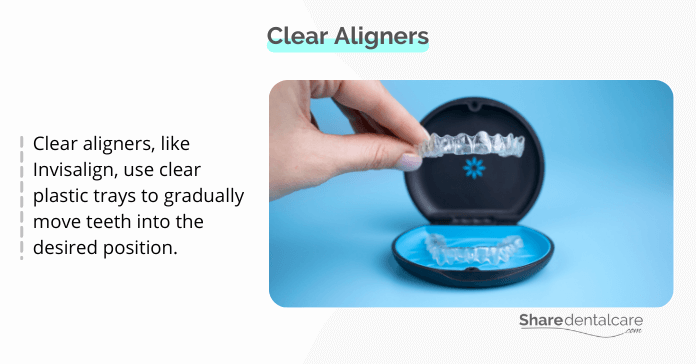Do you have overcrowded teeth? If so, you may be wondering what kind of treatment is available to help correct the issue. Teeth crowding can cause a lot of problems, including difficulty chewing, jaw pain, and an unattractive smile. Also, it increases your risk of tooth decay and gum disease. In this blog post, we will discuss the different treatment options available for overcrowded teeth. We will also discuss the benefits of each option.
What is Teeth Overcrowding & What Causes It?
Teeth overcrowding is a form of malocclusion that occurs when there is not enough space in the mouth for your teeth to erupt in the correct alignment. Teeth overlap each other, making it difficult to properly brush and floss your teeth. Overcrowded teeth can have several causes:
- Hereditary causes: This is the most common cause of teeth misalignment. Overcrowded teeth can be passed down from parents to children. Hereditary traits may affect the size and shape of the jaw, which can cause overcrowding.
- Early loss of primary teeth: If a baby tooth falls out too early, permanent teeth may move into the space.
- Over-retained primary teeth: If a primary tooth doesn’t fall out, the successor permanent tooth may not have enough room to erupt.
- Poor nutrition: Poor nutrition can cause the jaw and teeth to not grow properly.
- Injury or trauma: An injury or trauma to the mouth can cause teeth to shift out of alignment and become overcrowded.
- Large teeth (genetics): Large teeth can cause overcrowding as they take up more space in the mouth.
- Small jaw (genetics): A small jaw can cause overcrowding, as the teeth will not fit in the available space.
- Extra teeth: Having an extra tooth can cause overcrowding, as there is not enough room for all the teeth in the jaw.
Identifying the exact cause of your teeth crowding issue will help determine the best treatment option for you.

Why Overcrowded Teeth May Require Treatment?
If the teeth are slightly overcrowded (mild), you may not need treatment. However, if the overcrowding is moderate to severe, it may cause several problems, including:
- Difficulty brushing and flossing: Overcrowding can make it difficult to properly brush and floss your teeth, which can lead to plaque buildup and an increased risk of tooth decay and gum disease.
- Functional problems: Misaligned teeth can make it difficult to chew properly and may affect the way you pronounce certain words.
- Unattractive smile: Teeth overcrowding can make the smile look unattractive.
- Jaw pain: Overcrowded teeth can put a strain on the jaw and cause jaw pain.
- Low self-esteem: Overcrowding can make a person feel embarrassed or self-conscious about their smile.
If overcrowded teeth are causing any of these problems, it may be necessary to seek treatment.
Treatment Options for Overcrowded Teeth
The type of treatment you receive will depend on the severity of your overcrowding and what caused it.
Braces for Overcrowded Teeth Treatment
Dental braces are the most common treatment option for overcrowded teeth. They consist of metal brackets and wires that are attached to the teeth. Braces gradually move the teeth into their correct positions over time. They can be used to treat mild to severe teeth crowding. It usually takes 18-24 months for braces to fully correct the misalignment.
However, oral hygiene can be more difficult when wearing braces, so it’s important to brush and floss regularly. Also, some people don’t like the appearance of metal braces, as they are visible. Ceramic braces are available for a less noticeable look.

Clear Aligners
Clear aligners, like Invisalign, are an alternative to traditional braces. Instead of metal brackets and wires, Clear aligners use a series of clear plastic aligners to move the teeth into their correct positions. The treatment usually takes about 12-18 months, depending on the severity of the overcrowding.
Clear aligners are removable and virtually invisible, making them a popular treatment option for cosmetic reasons. Clear aligners can be used to treat most types of crowding. However, they may not be suitable for more severe cases of overcrowding or complex dental problems.

Dental Veneers
Dental veneers are thin, custom-made shells that fit over the front surface of the teeth. They are used to improve the appearance of crowded, crooked, and gapped teeth. Veneers can also be used to make minor corrections to the shape and length of the teeth.
Veneers can be used to correct mild overcrowding and can give you an instantly beautiful smile. However, they are not recommended for moderate to severe overcrowding as they may not be able to address the underlying problem. Braces and clear aligners are better options for the treatment of overcrowded teeth.
Surgery
In severe or complex cases of overcrowding, orthognathic surgery may be necessary. This involves repositioning the jawbone to make more room for the teeth. Surgery is an invasive procedure and only recommended for severe cases, as it can be a complex and expensive process, and require a lengthy recovery time.
Overcrowded Teeth Treatment – Conclusion
Overcrowded teeth can cause several functional and cosmetic issues. Dental braces are the most common treatment option for teeth misalignment. They can be used to treat mild to severe cases. However, some people don’t like the appearance of metal braces and prefer the more discreet option. Clear aligners, like Invisalign, are an alternative. They are removable and virtually invisible but may not be suitable for severe cases of overcrowding.
Veneers can also be used to improve the appearance of overcrowded, crooked, and gapped teeth. But they can only make minor corrections and may not address the underlying problem. It is important to speak with a dentist or orthodontist to determine the best treatment option for your overcrowded teeth.